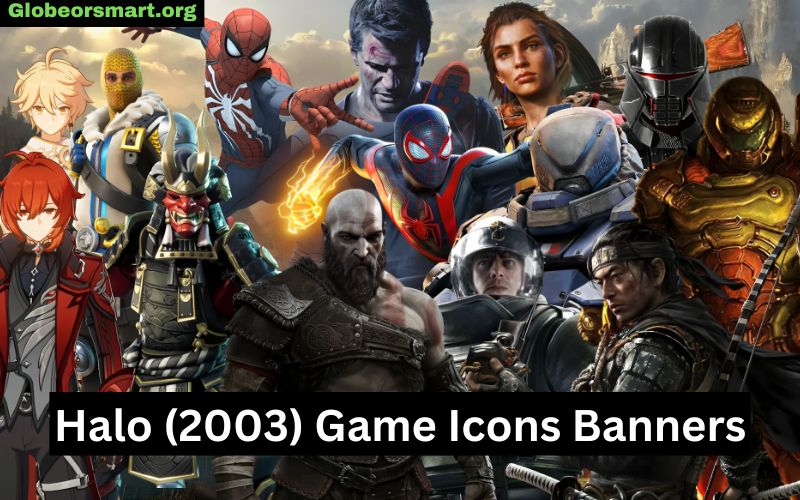Bitcoin(BTC)$91,403.000.77%
Ethereum(ETH)$3,036.011.41%
Tether(USDT)$1.00-0.02%
XRP(XRP)$2.20-0.66%
BNB(BNB)$896.952.16%
Solana(SOL)$138.821.31%
USDC(USDC)$1.000.01%
TRON(TRX)$0.2825850.56%
 Lido Staked Ether(STETH)$3,034.841.71%
Lido Staked Ether(STETH)$3,034.841.71%Dogecoin(DOGE)$0.1497901.12%

Halo (2003) Game Icons Banners That Defined a Gaming Legend
The year 2003 was a golden era in the world of video games, and one of the most iconic franchises that emerged during that time was Halo. Developed by Bungie and published by Microsoft Game Studios, Halo quickly became a household name, particularly with the success of its first entry, Halo: Combat Evolved, which was originally released in 2001. By 2003, the game had established itself as a leader in the first-person shooter (FPS) genre and a key pillar in Microsoft’s Xbox gaming platform. One of the elements that contributed to the game’s appeal was its distinctive visual design, particularly the use of icons and banners, which played a significant role in building the brand and community around Halo.
This article explores the significance of icons and banners in Halo (2003), delving into how they shaped the game’s identity, their role in marketing and community building, and their impact on the wider gaming landscape.
The Origins of Halo
Before diving into the world of icons and banners, it’s essential to understand the broader context of Halo as a game and franchise. Originally conceived as a real-time strategy game, Halo evolved into an FPS that combined intense combat with a deep narrative. Set in the 26th century, Halo: Combat Evolved thrust players into the role of Master Chief, a Spartan super-soldier fighting to defend humanity from the Covenant, an alien alliance bent on destruction.
From the start, Halo was designed to be more than just a game. It was a universe with rich lore, memorable characters, and a distinctive aesthetic that set it apart from other shooters of the time. The game’s success led to the development of sequels, spin-offs, and a vast fan base.
The Role of Icons in Halo (2003)
![]()
Icons in video games serve multiple purposes. They can be used to convey information, represent game elements, or serve as visual symbols of the game itself. In the case of Halo (2003), icons were a crucial part of the game’s user interface (UI), marketing, and branding.
Icons in the User Interface
The in-game UI of Halo was designed with a minimalist approach to ensure that players remained focused on the action. Icons were used to represent various elements such as weapons, health, shields, and objectives. These icons were simple yet effective, designed to be easily recognizable in the heat of battle.
For example:
- Weapon Icons: Each weapon in Halo had a distinct icon, making it easy for players to switch between them and identify what they were carrying. The design of these icons mirrored the weapon’s in-game appearance, making them instantly recognizable.
- Grenade Icons: Grenades played a significant role in Halo‘s combat mechanics, and the grenade icons were designed to be clear and distinguishable from other items in the player’s inventory.
- Shield and Health Icons: The game’s health and shield system was represented by a simple icon that would change color based on the player’s current status. This allowed players to quickly assess their condition without distracting them from the gameplay.
Icons in Multiplayer
Multiplayer was a significant component of Halo‘s success, especially with the release of Halo 2 in 2004. However, by 2003, multiplayer modes in Halo: Combat Evolved had already established a dedicated community. Icons in multiplayer were essential for team-based gameplay, with different symbols used to represent teams, player roles, and objectives.
- Team Icons: In team-based multiplayer modes, each team was assigned a unique icon or color, making it easy for players to identify allies and enemies.
- Objective Icons: Capture the Flag (CTF), one of Halo’s most popular multiplayer modes, used icons to mark the location of flags and bases. These icons were simple, using basic shapes like flags and arrows to guide players toward objectives.
The Master Chief Icon
Perhaps the most recognizable icon from Halo (2003) is the image of the Master Chief himself. The green armor and helmet of the super-soldier became synonymous with the game and the franchise. By 2003, Master Chief had already become a gaming icon, appearing in promotional material, box art, and marketing campaigns. The helmet, in particular, became a symbol of Halo, representing not just the character, but the entire universe of the game.
The Importance of Banners in Halo (2003)
While icons served as functional elements within the game, banners played a broader role in shaping the game’s identity outside of the gameplay itself. Banners in Halo were used for marketing, community events, tournaments, and fan creations, helping to solidify the game’s place in gaming culture.
Marketing Banners
In 2003, the gaming industry was transitioning into an era of large-scale marketing campaigns, and Halo was at the forefront of this change. Microsoft heavily promoted Halo as the flagship game for the Xbox console, and banners were a key part of these promotional efforts.
- Online Advertising: Banners for Halo appeared across gaming websites, forums, and online stores. These banners often featured striking images of Master Chief in action, alongside the Halo logo and taglines like “Combat Evolved.” The clean, futuristic design of these banners helped convey the sci-fi setting of the game.
- Store Displays and Posters: Physical banners and posters were also common in game stores during the early 2000s. These promotional materials often featured large images of the Halo ringworld, Master Chief, and iconic battles, designed to capture the attention of potential players.
Community and Tournament Banners
By 2003, Halo had developed a thriving community, and online multiplayer was beginning to take off. With this rise in popularity came the emergence of Halo-themed tournaments and fan events. Banners were often used to promote these events, both online and in physical venues.
- Tournament Banners: Local and regional Halo tournaments became common by 2003, and banners promoting these events often featured images of the game’s iconic multiplayer maps, along with details about the event, prizes, and sponsors.
- Fan Creations: The Halo community was known for its creativity, and fan-made banners were often shared on forums and fan sites. These banners were typically designed to celebrate achievements in multiplayer, announce clan activities, or showcase custom-made content.
In-Game Banners
Although less prominent than marketing and community banners, in-game banners still played a role in Halo‘s aesthetic. Flags, symbols, and other banners were used in multiplayer maps to denote teams, objectives, and locations. These banners were designed to fit the game’s military and sci-fi themes, often incorporating bold colors and sharp lines.
The Cultural Impact of Halo Icons and Banners
By 2003, the icons and banners associated with Halo had become more than just visual elements; they had become part of the broader gaming culture. The game’s distinct visual style, particularly its use of icons and banners, helped Halo stand out in a crowded market and cemented its place as one of the most iconic franchises in gaming history.
The Halo Logo
One of the most significant visual elements associated with the game is the Halo logo itself. The clean, futuristic font, paired with the circular shape of the ringworld, became instantly recognizable to gamers around the world. This logo was featured prominently in banners, trailers, and advertisements, and by 2003, it had become a symbol of quality in the FPS genre.
Influence on Other Games
Halo‘s success inspired many other developers to adopt similar design principles when it came to icons and banners. Games like Call of Duty, Gears of War, and Destiny (also developed by Bungie) all used similar visual elements in their user interfaces and marketing. The simple yet effective use of icons and banners in Halo became a standard in the industry, influencing game design for years to come.
FAQs
What role did icons play in Halo (2003)?
Icons were crucial in Halo‘s user interface, representing weapons, health, shields, and objectives. Their simple, recognizable design helped players quickly identify key elements and stay focused during gameplay.
How did banners contribute to Halo‘s success?
Banners were used in marketing campaigns, tournaments, and community events to promote Halo. In-game, banners marked objectives or teams, enhancing the multiplayer experience and helping build the game’s fanbase.
Why is the Master Chief icon significant?
The image of Master Chief, especially his helmet, became a symbol of the Halo franchise. By 2003, it was synonymous with the game and heavily featured in promotions, representing the entire Halo universe.
How did Halo‘s icons and banners influence gaming?
Halo set new standards for UI design and marketing in the gaming industry. Its effective use of icons and bold banners inspired many future games, like Call of Duty and Gears of War, in both design and branding.
Conclusion
Halo (2003) Game icon banners were more than just aesthetic choices; they were integral to the game’s identity and success. From the functional icons used in the user interface to the marketing banners that helped promote the game, these visual elements played a crucial role in shaping the world of Halo and establishing it as one of the most beloved franchises in gaming history.
As the gaming industry continues to evolve, the legacy of Halo‘s visual design endures. The icons and banners that defined Halo in 2003 continue to be remembered and celebrated by fans, serving as a testament to the game’s lasting impact on the world of gaming.
For More Information, Visit Our Site: GlobeorSmart
